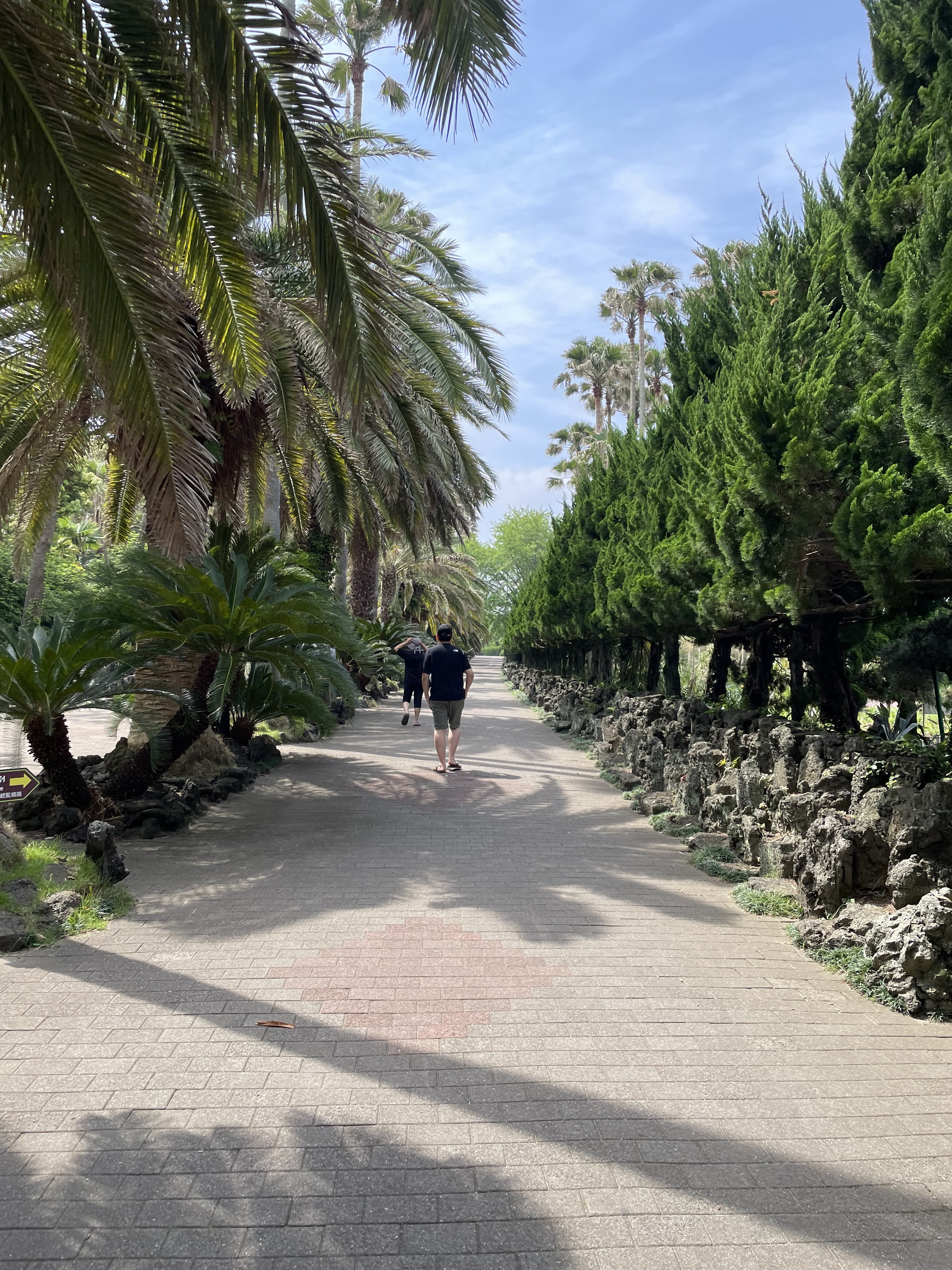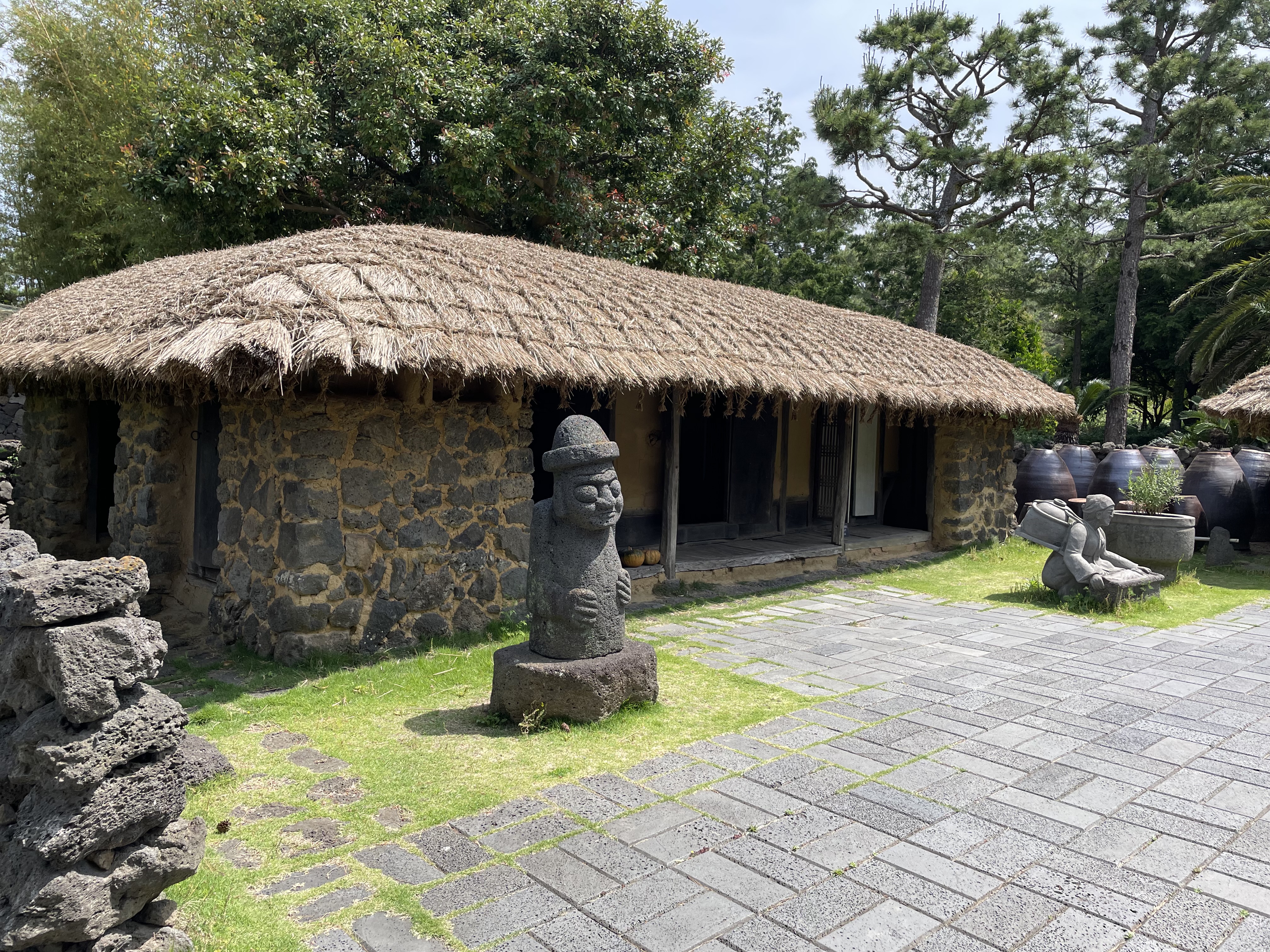In May 2023, I made a quick stop at Jeju Island during a 2 week vacation in South Korea. I also visited Seoul and Busan on that trip and you can read about them here (Seoul) and here (Busan). I was only on Jeju Island for 2 nights and a full day but I had a really good time and I would love to go back to check out other parts of the Island.
 |
| Map garden at the airport |
Jeju Island is the largest island and smallest province in South Korea. It is a volcanic island covered with lava rocks and one of its mountains (Mt Halla) contains a UNESCO World Heritage Site.* It is a really beautiful, chill place to visit, especially for nature lovers. However, if you love food and a slow-paced life, Jeju is also for you.
 |
| Cheonjeyon Falls |
I flew in from Busan in the evening and took a bus to Dongmun Traditional Market. It is the biggest and oldest traditional market in Jeju. They sell all kinds of street food, seafood, ice cream and general snack fare there. It is such a good time and I highly recommend visiting the market if you are in the area. Side note, the TMoney card is good for buses and subways all over South Korea so I used my card from Seoul in Busan and here on Jeju Island.
If you're lucky, you might even get a K-Pop show from the vendors as they cook and prep meals.
I got a single set combo of half-sized lobster and snow crab fried rice for ₩17,500 from them and grilled octopus from another place for ₩9,000.
I also got abalone eggroll gimbap for ₩8,000 then abalone with raw shrimp and glass noodles for ₩10,000. I split some of these with a new friend I met there who was also traveling solo. However, I ate most of it alone and had to take left overs because your girl was fuuuullll!!!
Due to a lack of convenient public transport all over the island, my limited time and lack of interest in renting a car on this trip, I opted for a day long tour to make the most of my day. The tour was $99 and it covered the western part of the island with multiple stops, entry fees and lunch included. I don't care much for tours when I have time and flexibility to do stuff myself but sometimes, it makes more sense to pay someone to take me around and explain stuff if the alternative is to faff about with high potential for misery. Food photo break.
My Airbnb was next to a bus stop so I took the bus to the meeting point at the airport and we headed out from there. The black Xs below show all the places I got to see on this trip.
Our first stop was at Geumneung Beach. This is a white sandy beach that also manages to have rocky outcrops and rock pools. It is really pretty and serene. If you walk up just a few minutes, you'll stumble onto the tourist hot spot that is Hyupjae Beach. It also has white sand, clear turquoise waters and you can see Biyangdo Island from there. We spent about 30 minutes in the area.
Next up, we drove to Jeju Hallim Park. In 1971, Song Bong-gyu (the founder) created a palm tree path by sowing palm seeds in 80 acres of wilderness and turned it into a botanical paradise.
Hallim Park is a subtropical botanic garden that has over 3,000 plants from all over the world. It is popular with both domestic and foreign tourists and it features 9 attractions including the palm tree avenue, a water garden, a bonsai garden, a bird garden, caves, a folk village and more.
Hyeopjae and Ssangyong caves were formed by an eruption of Mt. Halla*. They considered unique by geologists because they are known to be the only two-dimensional caves in the world. Fossilized seashells and abalone shells have been found there which lead them to believe that the caves were below sea-level at the time of formation. In the area, over 20 caves are connected in a single system spanning over 17,000m which is the longest in the world. Only a 500m portion of Hyeopjae and Ssangyong caves are currently open to public. The temperature inside of the caves is 17~18 degrees Celsius all year around so visitors get to enjoy a cool temperature in summer and keep warm in winter.
The Jeju Stone and Bonsai Garden, has collections of 300-year-old pines, quince trees, crape myrtle, azalea as well as zelkova, maple, and a persimmon tree.
Jaeam Folk Village was created by folklore used by ancient Jeju people in order to preserve the history of Jeju's traditional thatched houses. These thatch houses have gradually disappeared from the community with the development of modern civilization.
The Water Garden in Hallim Park has a large waterfall, aquatic plants (think lotus, water lillies etc), a tropical jungle and cacti in the back. You might also see some lizards from tropical regions.
We then headed to Suwolbong where we hiked for a little while and eventually to Jeju Aerospace Hotel for lunch.
We had a “local well-being” buffet lunch and I had a platter of Pajeon (Green onion pancake), lettuce kimchi, radish kimchi, greens, pork, sticky rice, lettuce, and broccoli with sauces. Ya girl was hungry!
Other options on the buffet included porridge, noodles, spaghetti, salad vegetables and seasonal fruits.
The “o“ in “o'sulloc“, means to appreciate and enjoy. You can of course buy tea to drink there or to take home and they have a variety of green tea ice creams and cakes.
The museum also has a lotus pond in the indoor garden, an observatory and outdoor seating. I had so much fun at this stop.
We got picturesque ocean views of Dragon Coast. The coast line (from the coast) looks like a dragon jumping into the ocean though it doesn’t quite capture it from the sea but you get the idea.
Finally, we saw Mt Songak. It has a cinder in the middle of its crater and has remained active) and some other things that I honestly don't remember... but a good time was had. Be sure to take a jacket because it got quite chilly.
After the cruise, we were asked to choose between going to the Teddy Bear Museum** or Cheonjeyeon Waterfalls and we all opted for the waterfalls.
Legend has it that, Cheonjeyon Falls means “the pond of God,” a sacred body of water where nymphs used to descend to take baths. It is collectively 2 waterfalls. The first cascade is 22m high and the water forms a pond 21m in depth. The water flows farther along to form the second cascades off a 30m high cliff. There is also a cave, east of the waterfalls, that has water dripping from it's stalactites, forming several streams of water. Historically, the water was used for drinking and it was believed that people could recover from any disease if they stood under the waterfall on either the Buddhist All Souls Day or Cheoseo Day (at the end of August).
Up from Cheonjeyon Falls is the stunning arch bridge Seonimkyo, which is also called Seven Nymphs Bridge.
Right next to the falls is Yeomiji Botanical Gardens and a beautiful temple.
I had intended on visiting Jeju Loveland (an outdoor sculpture park centered on intimacy) after my tour, as online searches showed that it stayed open until midnight. Unfortunately, I found out too late that the park had been closed since the pandemic started and yet to reopen. I was legit heartbroken but honestly so tired from the day's activities that I decided to nap before heading back out. However, I woke up at past 11pm and took it as my cue to rest my bones. I flew back to Seoul the next day then headed to Tokyo the day after.
This and that
* I highly recommend making time to visit Hallasan National Park if you make it to Jeju Island. It is smack dab in the middle of the country and it contains Mt. Halla (the tallest mountain in South Korea) which contains Jeju Volcanic Island and Volcanic Tubes, a UNESCO World Heritage Site! With my bad hip and terrible health, going west was the best option for me at the time but now that my health has improved and my hip is continuing to get stronger, I will definitely not miss an opportunity to see this for myself.
**Teddy Bear Museum has various themes depicting the history and art of Seoul from more than 100 years. They also offer a tour around the world and show other teddy bear related products. Displayed Teddy bears are handmade by designers with premium goat wool.
***Don’t forget to check out my posts on Seoul and Busan here and here, respectively.

































